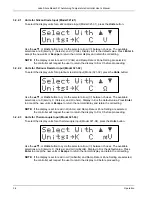
Lake Shore Model 321 Autotuning Temperature Controller User’s Manual
3-16
Operation
To experimentally determine the proper gain setting, use the following procedure. Set Autotune to
Manual, then turn off both Reset (I) and Rate (D). Set in a nominal gain setting of 50. Make sure
that the heater turns on; if not, increase the gain setting until the heater turns on. Let the system
stabilize. Note that it will stabilize at some point below the setpoint (typically 2 to 3 K below). Keep
increasing the controller gain by factors of two until the system temperature begins to oscillate.
Adjust the gain for small sustained oscillations. Measure the period of these oscillations for
determining the correct setting for reset. Reduce the gain by a factor of two to three until the
temperature again becomes stable with time. Be sure that you allow time at each setting for the
system to stabilize (if it will). For some systems and cryogenic sensors with low sensitivity, the
maximum gain is required.
3.3.5.2 Setting
Reset
(Integral)
Adjusts the reset time constant of reset (Integral) in the control function. Effective reset time
constants, between 1 and 999 seconds can be achieved by entering reset settings of 1 - 999. Reset
time in seconds is (999/Value Entered). A reset of zero will make the controller proportional only. To
enter a reset value, press the
I
button. You will see the following display.
This display shows the current Integral setting (the default setting is 20). Use the numeric keypad to
enter a new setting. Press
Enter
to accept the new Proportional setting or
Escape
to return the
normal display and retain the old setting. For example, if the Reset setting is 20 the reset time in
seconds is approximately 50 (999/20=50).
The reset number is an industrial control term which in the Model 321 corresponds to the number of
repeats (or time constants) per 1000 seconds. The time constant is 1000 divided by this number in
seconds. Consequently, a reset number setting of 20 corresponds to a time constant of 50
seconds. A system will normally take several time constants to settle into the set point, e.g. the 50
second time constant, if correct for the system being controlled, would result in a stable set point in
a time frame between 5 and 10 minutes.
The oscillation period which you measured in determining the appropriate gain setting is equal to
the reset time constant which is desired. Divide this number in seconds into 1000 and set the result
into the RESET register. This result is the number of repeats per 1000 seconds. If the system did
not oscillate at the highest gain setting, use the following procedure. Stabilize the temperature at a
high gain setting. Change the set point downward by one or two degrees and observe the time that
it takes for the temperature to change 60% of this excursion. Use this number as the reset time
constant; divide it into 1000 and set in the result as the RESET value.
3.3.5.3 Setting
Rate
(Derivative)
This adjusts rate time constant of derivative (D) in the control function. Effective settings are
between 0 seconds and 200% of 1/4 the reset time. In manual mode, rate is normally set at 1/4 the
reset time in seconds (100%), because larger values may cause system instability. To enter a rate
value, press the
D
button. You will see the following display.






























